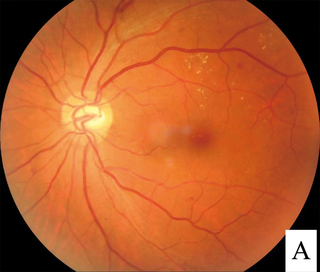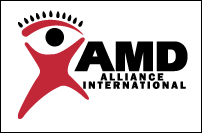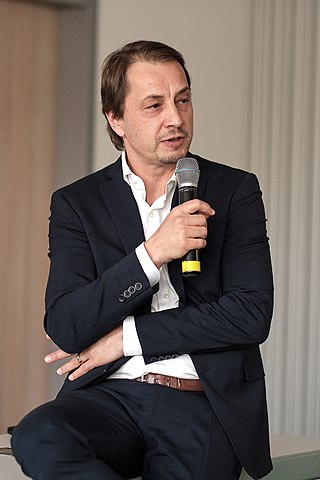
Ophthalmology is a surgical subspecialty within medicine that deals with the diagnosis and treatment of eye disorders.

Diabetic retinopathy, is a medical condition in which damage occurs to the retina due to diabetes mellitus. It is a leading cause of blindness in developed countries.
The National Eye Institute (NEI) is part of the U.S. National Institutes of Health (NIH), an agency of the U.S. Department of Health and Human Services. The mission of NEI is “to eliminate vision loss and improve quality of life through vision research.” NEI consists of two major branches for research: an extramural branch that funds studies outside NIH and an intramural branch that funds research on the NIH campus in Bethesda, Maryland. Most of the NEI budget funds extramural research.
This is a partial list of human eye diseases and disorders.
Ian Jeffrey Constable is an Australian ophthalmologist and the founder and director of the Lions Eye Institute in Perth, Western Australia. He was the Foundation Lions Professor of Ophthalmology at the University of Western Australia, and the Foundation Director of UWA's Centre for Ophthalmology and Visual Science. He is now Patron of the Lions Eye Institute.
Robert G. Devenyi FRCSC, FACS is a vitreoretinal surgeon and Professor of Ophthalmology and Vision Sciences at the University of Toronto. He is also the team ophthalmologist for the Toronto Maple Leafs of the National Hockey League. Devenyi is Ophthalmologist-in-Chief and Director of Retinal Services at the University Health Network (UHN), which is affiliated with the University of Toronto. Devenyi is also the co-director of the Donald K. Johnson Eye Institute located at the Toronto Western Hospital, part of UHN. The DKJ Eye Institute is one of Canada's subspecialty ophthalmology facility.
The Donald K. Johnson Eye Centre is Canada's largest clinical and research institute for vision. It is located in Toronto at the Toronto Western Hospital.

AMD Alliance International is a non-profit coalition of the world’s leading vision, seniors and research organizations working to raise awareness of age-related macular degeneration, understanding of available options for prevention, early detection, treatment, rehabilitation and support services. It is the only international organization in the world that concentrates exclusively on age related macular degeneration, the leading cause of vision loss in the developed world.
A visual prosthesis, often referred to as a bionic eye, is an experimental visual device intended to restore functional vision in those with partial or total blindness. Many devices have been developed, usually modeled on the cochlear implant or bionic ear devices, a type of neural prosthesis in use since the mid-1980s. The idea of using electrical current to provide sight dates back to the 18th century, discussed by Benjamin Franklin, Tiberius Cavallo, and Charles LeRoy.

The mission of the Foundation Fighting Blindness is to fund research that will lead to the prevention, treatment and cures for the entire spectrum of retinal degenerative diseases, including retinitis pigmentosa, macular degeneration, Usher syndrome, Stargardt disease and related conditions. These diseases, which affect more than 10 million Americans and millions more throughout the world, often lead to severe vision loss or complete blindness.
Bascom Palmer Eye Institute is the University of Miami School of Medicine's ophthalmic care, research, and education center. The institute is based in the Health District of Miami, Florida, and has been ranked consistently as the best eye hospital and vision research center in the nation.
The Universitäts-Augenklinik Düsseldorf is the department of Ophthalmology of the University Hospital of Düsseldorf in Germany. It is an internationally renown centre for corneal transplantation, ocular surface disease and management of associated disorders ranging from Glaucoma to oculoplastic surgery. Further subspecialist expertise is established for the diagnosis and surgical and medical treatment of vitreoretinal and macular disorders as well as strabismus.

John Marshall MBE, FMedSci, PhD, DSc, FRCPath, FRSB, FRCOphth(Hon), FRCOptom (Hon), FARVO is a British medical scientist and inventor. Currently he is the Frost Professor of Ophthalmology at the Institute of Ophthalmology UCL and Emeritus Professor King's College London. He is a pioneer of laser eye surgery.
Alan Charles Bird is an English ophthalmologist, famous for his work on degenerative and hereditary diseases of the retina.

Robert E. MacLaren FMedSci FRCOphth FRCS FACS VR is a British ophthalmologist who has led pioneering work in the treatment of blindness caused by diseases of the retina. He is Professor of Ophthalmology at the University of Oxford and Honorary Professor of Ophthalmology at the UCL Institute of Ophthalmology. He is a Consultant Ophthalmologist at the Oxford Eye Hospital. He is also an Honorary Consultant Vitreo-retinal Surgeon at the Moorfields Eye Hospital. MacLaren is an NIHR Senior Investigator, or lead researcher, for the speciality of Ophthalmology. In addition, he is a member of the research committee of Euretina: the European Society of Retina specialists, Fellow of Merton College, in Oxford and a Fellow of the Higher Education Academy.
Noemi Lois is a Clinical Professor of Ophthalmology at Queen's University Belfast and an Honorary Consultant Ophthalmologist and Vitreoretinal Surgeon at the Belfast Health and Social Care Trust.

Paul A. Sieving is a former director of the National Eye Institute, part of the U.S. National Institutes of Health. Prior to joining the NIH in 2001, he served on the faculty of the University of Michigan Medical School as the Paul R. Lichter Professor of Ophthalmic Genetics. He also was the founding director of the Center for Retinal and Macular Degeneration in the university's Department of Ophthalmology and Visual Sciences.
Professor Robyn Guymer was awarded an Elizabeth Blackburn Fellowship from the NHMRC, and works in ophthalmology at Melbourne University. Guymer is a senior retinal specialist within the Royal Victorian Eye and Ear Hospital, and is the deputy director, Centre for Eye Research Australia. She works in age-related macular degeneration as a clinician, academic, and researcher, and has used nano-lasers to treat Age-related Macular Degeneration.

Stem cell therapy for macular degeneration is the use of stem cells to heal, replace dead or damaged cells of the macula in the retina. Stem cell based therapies using bone marrow stem cells as well as retinal pigment epithelial transplantation are being studied. A number of trials have occurred in humans with encouraging results.

Peter Szurman is a German ophthalmologist, scientist, and professor of ophthalmology in Sulzbach/Saar.









